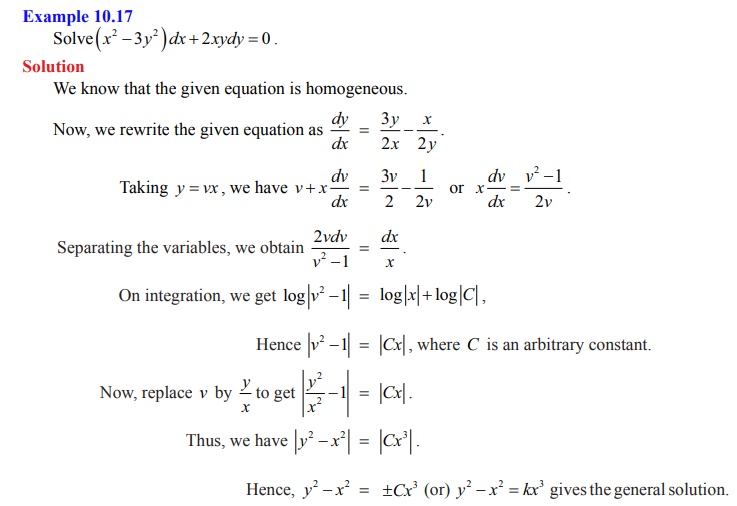Solution of First Order and First Degree Differential Equations | Mathematics - Homogeneous Form or Homogeneous Differential Equation | 12th Maths : UNIT 10 : Ordinary Differential Equations
Chapter: 12th Maths : UNIT 10 : Ordinary Differential Equations
Homogeneous Form or Homogeneous Differential Equation
Solution of First Order and First Degree Differential Equations
Homogeneous Form
or Homogeneous Differential Equation
Definition 10.12 : (Homogeneous Function of degree n)
A function f ( x, y)
is said to be a homogeneous function of degree n in the variables x and y if, f (tx
, ty ) = t n f ( x, y)
for some n ∈ ℝ for all suitably restricted
x , y and t . This is known as Euler’s homogeneity.
For
instance,
(i) f (x, y)
= 6x2 + 2xy
+ 4 y2 is a homogeneous function in x and y, of degree two.
(ii) But
f (x, y) =
x3 +
(
sin x)ey
is not a homogeneous function.
If f (
x, y) is a homogeneous function of degree zero, then there
exists a function g such that f (
x, y) is always expressed in the
form g(y/x) or g(x/y).
Definition 10.13: (Homogeneous Differential Equation)
An ordinary differential equation is said to be in homogeneous form, if the differential equation is written as dy/dx = g(y/x) .

Caution
The word
“homogeneous” used in Definition 10.7 is different from in Definition 10.12.
Remark
(i) The
differential equation M ( x, y)dx + N(
x, y)dy =
0 [in differential form] is said to be homogeneous if M and N are homogeneous
functions of the same degree.
(ii) The
above equation is also written as dy/dx
= f ( x, y) [in derivative form] where
f ( x, y)
= −M ( x, y) /
N ( x, y) is clearly
homogeneous of degree 0 .
For
instance
(1) consider
the differential equation (x2 − 3y2)dx + 2xy dy = 0 . The given
equation is rewritten as  .
Thus, the given equation is expressed as
.
Thus, the given equation is expressed as  Hence, (x2
- 3y2)dx + 2xydy = 0 is a
homogeneous is a homogeneous is a homogeneous
differential equation.
Hence, (x2
- 3y2)dx + 2xydy = 0 is a
homogeneous is a homogeneous is a homogeneous
differential equation.
(2) However,
the differential equation  is not
homogeneous. (verify!)
is not
homogeneous. (verify!)
To find
the solution of a homogeneous differential equation dy/dx = g(y/x), consider the substitution v = y/x. Then, y = xv and dy/dx = v + x dv/dx .Thus, the
given differential equation becomes x dv/dx
= f (v) − v which is solved using variables
separable method. This leads to the following result.
Theorem 10.1
If M ( x, y
) dx + N( x , y)dy = 0 is a homogeneous equation, then the change of variable y = vx, transforms into a
separable equation in the variables v
and x .





Related Topics